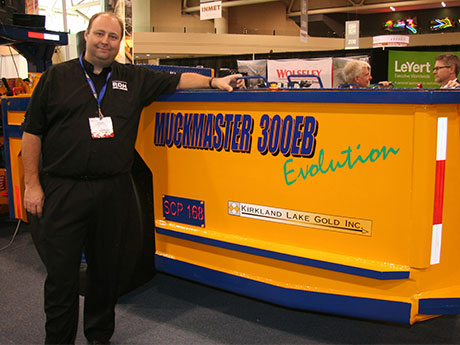August 13, 2013
by NORM TOLLINSKY
In: Sudbury Mining Solutions Journal
Eight loaders and three haul trucks sold to Kirkland Lake Gold

RDH Mining Equipment president Kevin Fitzsimmons with the battery-powered Muckmaster EB300 loader at the Canadian Institute of Mining and Metallurgy’s convention and trade show in May.
RDH Mining Equipment has unveiled what is likely the first battery-powered load-haul-dump (LHD) machine for the underground mining market.
Several years in development, the three-yard Muckmaster EB300 was showcased at the Canadian Institute of Mining and Metallurgy’s (CIM) 2013 convention and trade show in May.
Development of the battery-powered loader was driven by Kirkland Lake Gold in order to quickly access new ore zones without having to spend millions of dollars on new ventilation raises, explained Kirkland Lake Gold president Brian Hinchcliffe.
“Our COO, Mark Tessier, felt the technology was pretty mature, that we weren’t going too far out on the limb and that the rewards would be huge,” he said.
It was a long process, recalled RDH president Kevin Fitzsimmons.
“The prototype went on surface first and they got all of their operators to try it. Then it came back and we were asked to make some tweaks to it. It went to their health and safety committee, the Ministry of Labour was there… there were a lot of steps before it went underground in May 2012.”
The first battery-powered loader to be put in service had chalked up a full year of moving muck in May, so both Kirkland Lake Gold and RDH felt the time was right to unveil it at the CIM, held in Toronto May 5, 6 and 7. Kirkland Lake Gold now has eight EB300s and three 20-tonne battery-powered haul trucks.
Government regulations require 100 cfm of ventilation per horsepower for diesel equipment. Battery powered machines, however, have no emissions and aren’t subject to the same requirement.
The equipment is powered by lithiumiron-phosphate batteries, which deliver four hours of service – one hour more than is actually required.
“When they’re done with it, they drive it away and plug it in,” said Fitzsimmons. The truck delivers two hours of service on a 20 per cent grade, after which, “they swap out the pack” and keep going. “The recharge time is 90 minutes, so after the two hours, the next battery pack is ready to go,” added Fitzsimmons. “It’s not like a lead acid battery where you have one on charge, one on the machine and one cooling down. These don’t need to be cooled down.”
The battery pack for the truck weighs in at 7,500 pounds and can be swapped out in 15 minutes using a crane. The battery pack for the LHD weighs 5,000 pounds.
The loader has more than enough power to dig into the muckpile, notes Fitzsimmons.
“When it first went underground at Kirkland Lake Gold, the guys were a bit skeptical. Now, the eldest of the muckers are racing to be the first one on them because they have no end of power, the heat is a lot less and they’re quiet.”
Speed is also more constant. A diesel-powered loader governed to run at five kilometres per hour will slow down a bit with a full bucket, whereas “the battery-powered machine will go down a ramp at five kilometres per hour and up a ramp at five kilometres per hour,” said Fitzsimmons.
How is it that a small underground equipment manufacturer based in Alban, Ontario, 60 kilometres south of Sudbury, was able to beat much larger equipment manufacturers in the race to develop battery-powered underground machines?
The credit goes to RDH founder, Rick Lemieux, who sold the company to son-in-law Fitzsimmons and three senior RDH employees two years ago.
“My father-in-law was a risk taker and it was his dream,” said Fitzsimmons. Also, “when you have a smaller company and you want to do a new project, it’s a lot easier. Bigger companies have so much red tape. I’ve talked to engineers from other companies who said they would have liked to do something like this, but they were told ‘No, we don’t have the budget.’”
Word is getting out about RDH’s breakthrough. Personnel from Goldcorp’s Red Lake operation have checked out the EB300 and liked what they saw, and Kirkland Lake Gold itself has given RDH an order for four more loaders.
“They’re very powerful units,” said Hinchcliffe. “We’re very happy with how they’re performing.” RDH has also had inquiries about six and 13-yard battery-powered loaders and is willing to scale up “if someone wanted to work with us,” said Fitzsimmons.

Great job. can you make a six yard mucker. L.H.D. and how long would it take to build. thank you. mitch lipsky, michels tunneling .
Thanks for your interest Mitch. A sales representative will contact you directly to answer any questions you may have.
Why did you use LFP instead of NCA technology in the batteries? The NCA format holds significantly more power per wt/volume.
Hi George,
We do use lithium iron phosphate (LiFePO 4) batteries, also called LFP battery, in our equipment.
Thank you for your question.